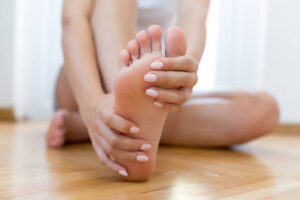Happy Feet
 I must admit, feet are my least favorite area to thoroughly assess in physical therapy! Feet are the terminal anatomical structure for weight-bearing and mobility function, which make them susceptible to diseases as entry points for parasites/bacteria and injuries e.g. ankle sprain, plantar fasciitis, Achilles tendinopathy, and stress fractures etc. Often, I assess for sensation and check for any pressure/diabetic sores (particularly with DM patients), or circulation for PAD/PVD patients. Semmes-Weinstein monofilament test (assessing the threshold stimulus for perception of light touch to deep pressure) for foot protective sensation is required in my work due to our advocacy of fall prevention. Of course, feet are assessed for motor function and with gait analysis, paramount portions of assessment or reassessment. Rarely have I had any complaint with foot MSK issues, but as sequelae to chronic comorbidities e.g. dependent swelling due to CHF or neuropathy, or other circulation problems, these are more common! I do wonder, however, if most people take feet for granted in favor of knee or hip? Thus, fewer reports…?
I must admit, feet are my least favorite area to thoroughly assess in physical therapy! Feet are the terminal anatomical structure for weight-bearing and mobility function, which make them susceptible to diseases as entry points for parasites/bacteria and injuries e.g. ankle sprain, plantar fasciitis, Achilles tendinopathy, and stress fractures etc. Often, I assess for sensation and check for any pressure/diabetic sores (particularly with DM patients), or circulation for PAD/PVD patients. Semmes-Weinstein monofilament test (assessing the threshold stimulus for perception of light touch to deep pressure) for foot protective sensation is required in my work due to our advocacy of fall prevention. Of course, feet are assessed for motor function and with gait analysis, paramount portions of assessment or reassessment. Rarely have I had any complaint with foot MSK issues, but as sequelae to chronic comorbidities e.g. dependent swelling due to CHF or neuropathy, or other circulation problems, these are more common! I do wonder, however, if most people take feet for granted in favor of knee or hip? Thus, fewer reports…?
Feet are so complex! I remember in anatomy class that hindfoot is for weightbearing/stability, midfoot is as fulcrum and forefoot is for mobility. It has always been an enigma to me how my little feet carry the stress loaded on them everyday particularly when I am hopping, jumping or running, not to mention what if I am barefooted! I always wondered if there is a difference with performance during running if one runs on forefoot/midfoot or on hindfoot. Then I came across this study of Liebman DF et al. So, here is more perplexing statement from the study that somehow answers my query, “Forefoot and midfoot-strike gaits were probably more common when humans ran barefoot or in minimal shoes, and may protect the feet and lower limbs from some of the impact-related injuries now experienced by a high percentage of runners.” Study also stated that when a foot landed on a forefoot, there is decreased impact between the mass of the body and the ground. Yet, this is for endurance runners. Heel strike is still the initial loading motion with kinetics of gait.
So, when I do gait analysis while walking or running, I look for the gait pattern and from there I would hypothesize the possible origin of a pain or function loss complaint. I find the most stressful movement that may plausibly explain a condition. For instance, stance phase. In kinetics, I always think about the ankle being neutral with pretibials in isometrics during heel strike, transition to foot flat would be an eccentric contraction, on midstance, at approximately 5-10 deg.dorsiflexion. Triceps surae should be eccentric to heel off, transitioning to concentric contraction. Any biomechanics changes like limitation of motion in any of this would affect the connecting region, which is the knee… the hip…
Treat your feet well! Begin by wearing shoes because it is comfortable, not for aesthetic reasons. Although, it is not a sin to do so once in a while.
Click here for recommended Mens shoes
Click here for recommended Womens shoes
